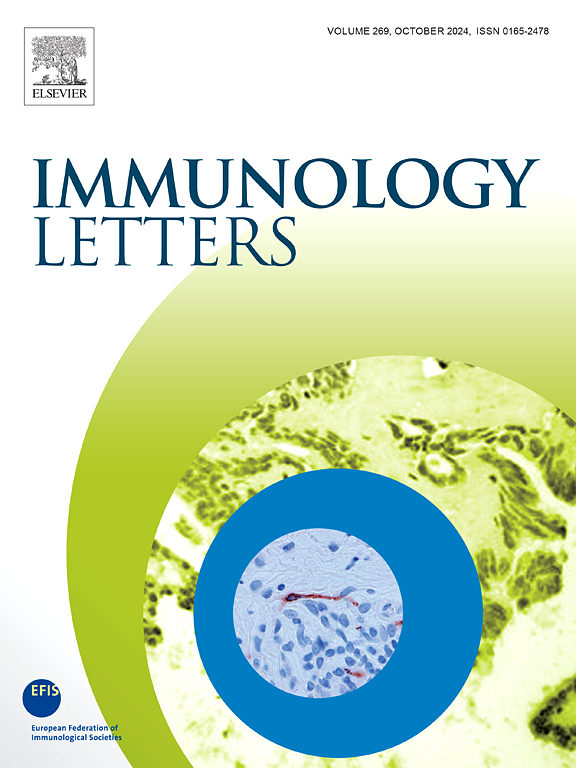NLRC3 affects the development of psoriasis by modulating the NF-κB signaling pathway mediated inflammatory response through its interaction with TRAF6
IF 2.8
4区 医学
Q3 IMMUNOLOGY
引用次数: 0
Abstract
Objective
The function and mechanism of NOD-like receptor family CARD-containing 3 (NLRC3) in psoriasis are not yet reported, even though it plays a crucial role in innate and adaptive immunity by inhibiting inflammation. Therefore, this research aims to investigate the role and mechanism of NLRC3 in psoriasis.
Methods
HaCaT cells were induced to form a psoriasis cell model using 20 ng/mL IL-1β, 20 ng/mL IL-17A, 20 ng/mL IL-23, 50 ng/mL TNF-α, and 20 ng/mL oncostatin M. Cell Counting Kit-8 (CCK-8) assay and flow cytometry were assessed to determine the proliferation, cell cycle, and apoptosis of HaCaT cells. Reverse transcription-quantitative polymerase chain reaction (RT-qPCR) was utilized to measure the knockdown efficiency of NLRC3 and TRAF6 interfering RNA in HaCaT cells. Western blot analysis was performed to determine the expression levels of NLRC3, TRAF6, and proteins associated with the NF-κB signaling pathway. A mouse model of psoriasis-like dermatitis was established by evenly applying miquimod cream (62.5 mg/day) to both ears. Hematoxylin-eosin staining was used to measure ear thickness and inflammatory infiltrates in mice. Histological analysis, immunohistochemistry, and terminal deoxynucleotidyl transferase dUTP nick end labeling (TUNEL were performed to detect cell proliferation and apoptosis. Interactions between NLRC3 and TRAF6 were predicted using the STRING database (https://cn.string-db.org/). Co-Immunoprecipitation was used to confirm interactions between NLRC3 and TRAF6. Ubiquitination of TRAF6 was assessed by Western blot.
Results
Knockdown of NLRC3 expression promoted cell proliferation and inhibited cell apoptosis in HaCaT cells. In vivo, knockdown of NLRC3 expression significantly increased the infiltration of inflammatory cells and the proliferation of Ki-67 positive cells within mouse ear epidermis, while decreasing the number of apoptotic cells. NLRC3 interacted with TRAF6 and influenced its K63 ubiquitination level. Knockdown of TRAF6 expression resulted in increased cell proliferation and decreased cell apoptosis in HaCaT cells. In vivo, knockdown of TRAF6 expression led to a significant increase in inflammatory cell infiltration and Ki-67 positive cells in mouse ear epidermis, and a decrease in apoptotic cells. Inhibiting the NF-κB signaling pathway alleviated the progression of psoriasis, and interfering with TRAF6 activated the NF-κB signaling axis, contributing to the onset and advancement of psoriasis.
Conclusion
NLRC3 affects the occurrence of psoriasis by regulating TRAF6 and influencing the NF-κB signaling axis-mediated inflammatory response. This finding offers a theoretical foundation for the treatment of psoriasis.
NLRC3通过与TRAF6的相互作用,调节NF-κB信号通路介导的炎症反应,从而影响银屑病的发展。
目的:nod样受体家族CARD-containing 3 (NLRC3)在银屑病中的作用和机制尚未报道,尽管它通过抑制炎症在先天免疫和适应性免疫中发挥重要作用。因此,本研究旨在探讨NLRC3在银屑病中的作用及机制。方法:用20 ng/mL IL-1β、20 ng/mL IL-17A、20 ng/mL IL-23、50 ng/mL TNF-α、20 ng/mL oncostatin m诱导HaCaT细胞形成银屑病细胞模型,采用细胞计数试剂盒-8 (CCK-8)法和流式细胞术检测HaCaT细胞的增殖、细胞周期和凋亡情况。采用逆转录-定量聚合酶链反应(RT-qPCR)检测HaCaT细胞中NLRC3和TRAF6干扰RNA的敲除效率。Western blot检测NLRC3、TRAF6及NF-κB信号通路相关蛋白的表达水平。采用双耳均匀涂抹米喹莫特乳膏(62.5 mg/d)建立牛皮癣样皮炎小鼠模型。苏木精-伊红染色法测定小鼠耳壁厚度及炎症浸润情况。采用组织学分析、免疫组织化学和末端脱氧核苷酸转移酶dUTP缺口末端标记(TUNEL)检测细胞增殖和凋亡情况。使用STRING数据库(https://cn.string-db.org/)预测NLRC3和TRAF6之间的相互作用。采用共免疫沉淀法确认NLRC3和TRAF6之间的相互作用。Western blot检测TRAF6的泛素化程度。结果:敲低NLRC3表达可促进HaCaT细胞增殖,抑制细胞凋亡。在体内,敲低NLRC3表达可显著增加小鼠耳表皮内炎症细胞的浸润和Ki-67阳性细胞的增殖,同时减少凋亡细胞的数量。NLRC3与TRAF6相互作用,影响其K63泛素化水平。敲低TRAF6表达导致HaCaT细胞增殖增加,细胞凋亡减少。在体内,敲低TRAF6表达导致小鼠耳表皮炎症细胞浸润和Ki-67阳性细胞显著增加,凋亡细胞减少。抑制NF-κB信号通路可缓解银屑病的进展,干扰TRAF6激活NF-κB信号轴,参与银屑病的发病和进展。结论:NLRC3通过调节TRAF6,影响NF-κB信号轴介导的炎症反应,影响银屑病的发生。这一发现为银屑病的治疗提供了理论基础。
本文章由计算机程序翻译,如有差异,请以英文原文为准。
求助全文
约1分钟内获得全文
求助全文
来源期刊

Immunology letters
医学-免疫学
CiteScore
7.60
自引率
0.00%
发文量
86
审稿时长
44 days
期刊介绍:
Immunology Letters provides a vehicle for the speedy publication of experimental papers, (mini)Reviews and Letters to the Editor addressing all aspects of molecular and cellular immunology. The essential criteria for publication will be clarity, experimental soundness and novelty. Results contradictory to current accepted thinking or ideas divergent from actual dogmas will be considered for publication provided that they are based on solid experimental findings.
Preference will be given to papers of immediate importance to other investigators, either by their experimental data, new ideas or new methodology. Scientific correspondence to the Editor-in-Chief related to the published papers may also be accepted provided that they are short and scientifically relevant to the papers mentioned, in order to provide a continuing forum for discussion.
 求助内容:
求助内容: 应助结果提醒方式:
应助结果提醒方式:


